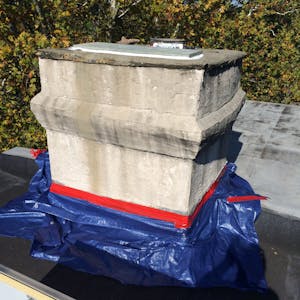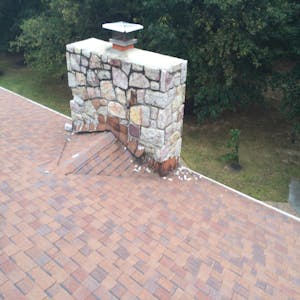A leaky chimney is a frustrating problem that can wreak havoc on the structure of your home if not addressed properly. The moisture caused by a leaky chimney can cause mold, rot wood, or damage to finishes like plaster, wallpaper, or paint. If left undetected or ignored, damage caused by chimney leaks can cause the whole chimney to collapse, or worse, even part of your home.
If you see a telltale moisture spot on the ceiling where the chimney meets the wall or moisture on the face of the fireplace, in the firebox, or when the fireplace is cleaned out, it is highly likely that you have a leaky chimney. There are several reasons why a chimney may leak after a heavy rain, snow, or even chronically. It is important to properly diagnose the origin of the leak so that the problem can be corrected at the source.
At McNamara Masonry Restoration, we specialize in diagnosing and correcting chimney leaks. Customer care and satisfaction are our top priorities, and we proudly stand behind the work that we do with a five-year guarantee on labor and materials.
Potential Chimney Leak Sources
There are five common sources of chimney leaks:- Water leaking through the top of the chimney can cause rain or snow to enter the chimney and collect in the firebox. There should be a cap on the chimney to prevent water, debris, and even animals from collecting in your chimney. If your chimney cap is damaged or missing, this is a simple fix and repairing it or replacing it could stop the perceived leak.
- Cracks in the chimney crown can cause water to gather between the chimney and the flue lining, which in turn can damage ceilings and walls. Water enters directly through the cracks and over time, the cracks enlarge and the problem worsens.
- Condensation can build up over time if your chimney liner is faulty or was installed incorrectly.
- Damaged or poorly installed chimney flashing is a common problem because it is difficult to install properly and rusts and deteriorates over time. Chimney flashing is sheet metal installed between the chimney and the roof to create a watertight seal. Flashing should be checked regularly for damage, because if left undetected, leaks in this area can cause serious structural damage.
- Deteriorating mortar is unfortunately a natural effect that aging has on the integrity of your chimney. Over time, as the mortar weakens, moisture can enter through the cracks and crevices. In the wintertime, changes in temperature cause the water in the cracks to freeze and thaw over time. This creates movement in the mortar, and bits of masonry will start to flake and break off. This is a structural problem as it can cause your chimney to lean or collapse if not addressed.
Our Process for Finding a Chimney Leak
At McNamara Masonry Restoration, we follow a time-tested protocol whenever we suspect a chimney leak. This ensures that we check the integrity of every part of the structure of the chimney to address the leak. We start by inspecting the exterior of the chimney, beginning at the top. The terra-cotta flue pipe is the highest point of the chimney. We inspect this flue pipe to ensure that it is sound, without any cracks.
Next, we check around the flue where it meets the concrete wash. An opening around the flue can allow water to penetrate the interior from the sides of the flue pipe. We also check the cap over the flue. We want to be sure it’s installed correctly and is in good condition.
We move down the chimney inspecting the top wash, crown or splay. This is the concrete or cement surrounding the flue at the top. We want to be sure the wash is free of any cracks and is properly pitched away from the flue pipe. This is the most critical part of the chimney in terms of waterproofing. If the wash is installed properly with the correct material, the chimney should stay intact for a very long time. Once this wash starts to fail, it creates a domino effect. Water will seep into the top of the chimney and start to compromise the masonry starting at the top and working its way down to the bottom.
Inspecting the chimney from the wash to the roofline is the bulk of the chimney. This is the area that causes the majority of leaks. Whether it is brick, stone, or stucco, once the masonry begins to fail in this area, it starts to seep through the failed mortar joints or failing stucco. Next we look at the chimney where it meets the roof, or the flashing. This is also a very critical part of the chimney.
If the leaks starts anywhere from the roofline to the top of the chimney, it will be corrected if this protocol is followed.
Local Experts in Chimney Restoration
McNamara Masonry Restoration has over 20 years of experience in masonry repair, restoration, and construction in the Greater Delaware Valley. Are you concerned about a possible chimney leak? Don’t postpone taking care of your greatest asset, your home. McNamara Masonry will get the job done quickly and accurately. Do not hesitate to call us today to schedule an expert chimney inspection.


